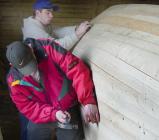46
The first bottom plank, called the garboard, was nailed into place next to the keel.48
Planking continued up from the bottom of the boat toward those previously installed from the top.50
Each plank was held in place with c-clamps while it was being attached to the body of the boat.52
The last plank installed on each side of the boat, between the top and bottom planking, was called the fuller.54
The last section of the fuller was installed. It was possible to use hull- length planks for the construction of punts and smaller motorboats, however it was also quite acceptable and considered no less inferior to install plank strakes consisting of two pieces which were butt-joined on a timber. The maximum length of suitable plank sticks to be found in the Winterton area was probably no more than 20 feet.55
Another view of planking completed on one side2003
Winterton Boat Building and Community Museum, Newfoundland and Labrador, Canada

56
The boat was then turned over so that planking could begin on the other side.57
Stopwaters are installed2003
Winterton Boat Building and Community Museum, Newfoundland and Labrador, Canada

58
Holes were drilled at the points where the bottom edge of the garboard plank would intersect a scarf joint. A round wooden peg called a stopwater was then driven into each of these holes to prevent water from seeping into the hull. These were located at the stem and keel scarfs and where the deadwoods or stern members met the keel.59
Setting nails and fairing the planks2003
Winterton Boat Building and Community Museum, Newfoundland and Labrador, Canada




